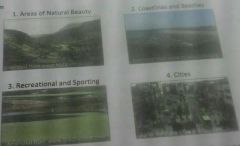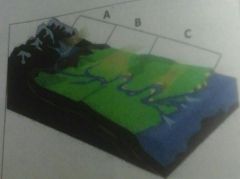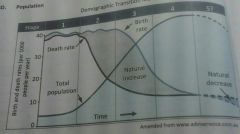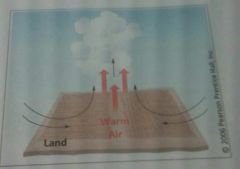![]()
![]()
![]()
Use LEFT and RIGHT arrow keys to navigate between flashcards;
Use UP and DOWN arrow keys to flip the card;
H to show hint;
A reads text to speech;
20 Cards in this Set
- Front
- Back

Choose one of the four tourist regions above and name a specific example in Ireland of this tourist region. |
Cities eg. Dublin. |
|
|
Explain one reason why tourists are attracted to the tourist region in Ireland that you have named. |
The capital has many attractions to offer such as Temple Bar, Trinity College, the Book of Kells, the National Museum and the National Gallery. |
|
|
Describe one positive economic impact of tourism. |
Tourism provides employment directly in hotels, restaurants and bars and for those that run activities for tourists, such as water sports and golfing holidays. |
|
|
Describe one negative impact of tourism on the environment. |
Sewage schemes are not able to cope with the ever-increasing numbers and some of the waste enters the Mediterranean Sea, causing pollution. |
|
|
Explain two reasons for the over-exploitation of fish. |
Mesh sizes : the mesh sizes in the nets used to be too small and it led to young, undeveloped fish being caught. This reduced the opportunity for the fish to breed and to replace their stocks. Seasons and quotas : as there was no closed fishing season, fish could be caught all year round. The lack of quotas meant there was no limit to the amount of fish a trawler could catch. |
|
|
Describe two measures that used to prevent the over-exploitation of fish. |
An increase in net mesh sizes. The shortening of the fishing season for some types of fish. |
|
|
Describe and explain three reasons why the location of Britain's iron and steel industry has changed over time. |
As the population in Britain grew, so did the demand for timber. As forests were cut down, the wood had to be carried further to towns and this became very expensive. Coal was a better form of power than wood, because it provided up to three times more energy. Steel mills were built beside the coal mines because coal is a bulky heavy raw material and it was expensive and time consuming to transport it. Locating a factory beside the coast is now more favourable , so that goods can be exported as they are produced. |
|

The diagram above shows the three stages of a river. (i) Name each of the three stages A, B and C. (ii) name one feature formed by river erosion, and with the aid of a labelled diagram, explain how it was formed. |
(i) A = youthful stage B = mature stage C = old stage (ii) A V-shaped valley is a steep-sided valley in the shape of a V, down which the river flows from its source. It's shaped by vertical erosion, the river cuts down into the river bed, making it deeper. This process is called hydraulic action. It creates a deep narrow valley. Mechanical weathering and mass movement also weather the sides of the valley, breaking down rocks and soil. Examples of this are seen in the upper course of the River Liffey, the River Lee and the River Moy.
|
|
|
Explain one way in which flooding damages an area. |
When humans cut down trees, it can lead to more surface runoff as well as soil erosion and this can lead to deposition on river beds causing the river to rise and burst it's banks. |
|
|
Explain two advantages of hydroelectric power. |
The reservoir ( the water that builds up behind the dam) can provide a water supply to urban areas. The reservoir can also be used for leisure activities such as fishing, boating and water sports. |
|
|
Describe two objections which might be made to the development of a hydroelectric power station. |
The creation of a reservoir behind the dam may mean losing good agricultural farmland. Families living in the dam and reservoir have to be relocated from their homes. |
|
|
What name is given to the process where nutrients are washed down through soil? |
Leaching. |
|
|
Name any two Irish soil types. |
Gley soils and peaty soils. |
|
|
Describe and explain the formation of any one of the soil types that you have named. |
Gley soils are grey in colour and develop where the bedrock, or the clay above it, is impermeable. They are sticky and waterlogged, which makes the land difficult to cultivate and so it is used only for pastoral farming. |
|
|
State what is meant by the term bilateral aid. |
This is where one government gives money to another government. |
|
|
Explain two advantages of aid to countries in the developing world. |
In times of natural disaster, emergency aid is vital in saving lives. Healthcare and education improve drastically when development aid is given, and the money is spent in the right way. |
|
|
Explain how any two of the following factors have slowed up economic development in a developing country that you have studied : Climate change Population growth Arms expenditure War. |
Climate change Long periods of drought in Sierra Leone has led to desertification. The soil is overused and becomes infertile. Because of the tropical climate, animals die and crops fail, leading to famine, hunger and death. War A bitter civil war that lasted for 11 years resulted in 67% of children not attending school. They were forced to fight as child soldiers. Over 1500 schools were destroyed during the conflict. This made it very difficult for the country to recover and grow. |
|

The Demographic Transition Model above shows population change over time. (i) state two reasons why the death rate is fluctuating in stage 1. (ii) explain one reason why total population is increasing rapidly in stage 2. (iii) explain one reason why birth rates are declining in stage 4. (iv) name one example of a country in stage 4 of the demographic transition model. |
(i) total population is balanced due to high death rates cancelling out high birth rates. (ii) total population rises as death rates fall due to developments and improvements in food supply, health care and sanitation. (iii) parents plan their families and there is a desire for smaller families. (iv) ireland. |
|

(i) name the type of rainfall associated with the diagram above. (ii) describe and explain how thus type of rainfall occurs. |
(i) convectional rain. (ii) the sun heats up the ground. Warm air rises, as it rises it becomes cooler and condenses to form clouds. These clouds produce rain and possibly thunder and lightning. |
|
|
Explain how any three of the following factors influence climate: Latitude Prevailing winds Distance from seas and oceans Altitude Relief. |
Latitude is the angular distance of a place north or south of the equator. Areas closer to the equator are warmer because the Sun's energy is greatest at the equator. The further you travel from the equator, the cooler it gets because the Sun's rays have a longer distance to travel and become slanted. Distance from the sea and oceans During the summer the sea water is cooler than the land and during the winter it is warmer. Areas close to the sea have cool summers and mild winters. Areas further from the sea have warm summers and cold winters. Altitude The higher a place is above sea level the colder it is. The temperature drops by about 1°C for every 100m increase in altitude. Upland areas are more exposed to wind and rain. |

